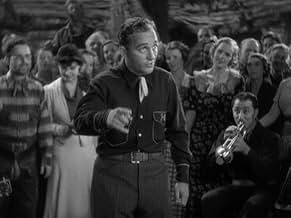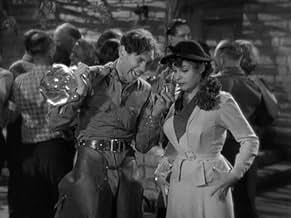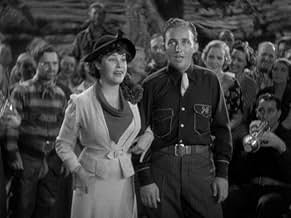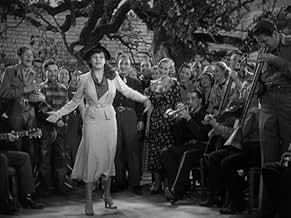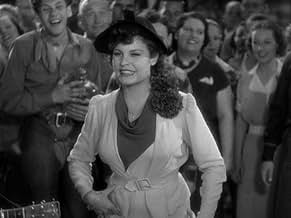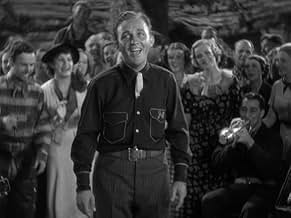अपनी भाषा में प्लॉट जोड़ेंCowboy Jeff Larabee returns from the east and meets Doris Halloway, a young girl, that he regards as a vagabond, till he learns that she's the owner of the ranch where he works. He tries to ... सभी पढ़ेंCowboy Jeff Larabee returns from the east and meets Doris Halloway, a young girl, that he regards as a vagabond, till he learns that she's the owner of the ranch where he works. He tries to win her heart, but without success, until she is endangered by gangsters.Cowboy Jeff Larabee returns from the east and meets Doris Halloway, a young girl, that he regards as a vagabond, till he learns that she's the owner of the ranch where he works. He tries to win her heart, but without success, until she is endangered by gangsters.
- पुरस्कार
- कुल 1 जीत
- Penelope Ryland
- (as Lucille Webster Gleason)
- Dining Car Steward
- (बिना क्रेडिट के)
- Train Brakeman
- (बिना क्रेडिट के)
- Rodeo Announcer
- (बिना क्रेडिट के)
- Rodeo Cowboy
- (बिना क्रेडिट के)
फ़ीचर्ड समीक्षाएं
The duet one of the previous commenters mentioned, "The House Jack Built for Jill," was in fact filmed but was not, as that commenter stated, slated for the end of the film, but rather for the scene where Bing and Frances escape the rainstorm and find shelter in the farmhouse. I have Norman Taurog's original shooting script and the scene is still extant in the script, including Taurog's blue line through the pages indicating it was filmed.
One of the previous commenters repeated some unfortunately commonly believed misinformation about Frances. Though Frances' institutionalization was certainly no picnic (to say the least), the most horrifyingly sensationalized allegations about her treatment (found in both her ghost-written autobiography and the largely fictionalized "Shadowland") never happened, including the spurious claim that she was lobotomized. My article detailing the truth about these allegations, "Shedding Light on Shadowland," is linked under the Miscellaneous section on the IMDb listing for Frances Farmer. Or you can find it by using a search engine and searching for "Shedding Light on Shadowland."
When the film begins, Doris (Frances Farmer) is rehearsing for her wedding. She's a spoiled woman and freely admits she's marrying more out of boredom than anything else! Fortunately, when she goes to a rodeo and sees the buff he-man, Jeff Larabee (Crosby) she is smitten...though he seems more smitten with a cow! Strange as it is, this is the film in a nutshell!
While casting Crosby as a cowboy was stupid and udderly ridiculous, this film manages to be a lot of fun. Even with the inclusion of Martha Raye (who is usually too brash and obnoxious), it's still filled with neat songs and characters. Brilliant or sophisticated? No way...but still somehow fun and worth seeing.
By the way, during a song and dance number late in the film, it's Louis Prima singing and playing trumpet. He wasn't yet famous and later would gain eternal fame as King Louie in the cartoon "The Jungle Book".
Runaway heiresses were another movie staple especially in the 1930s and that's Frances Farmer's part. She's running away from a marriage she's not terribly thrilled about and stowing away on a freight boxcar she finds Bing Crosby who unbeknownst to her works as a ranchhand on her aunt's Frying Pan Ranch out in Arizona. Bing is nursemaiding a bull named Cuddles and Bing, Frances and Cuddles make their way west with several adventures. Trailing them are a trio of hoboes played very well by James Burke, Warren Hymer, and George E. Stone who have found out who Frances is and are looking to make a quick buck. Their machinations go for naught of course.
In Frances Farmer's book, Will There Ever Be A Morning, she describes a not very happy life in Hollywood. However she liked this film, as it had no pretensions and similarly her leading man. She described Bing Crosby as a pleasant unassuming fellow who she liked, but didn't get to know real well. Frances had a best friend, a matron of honor to be, for the wedding that didn't come off. She was played by Martha Sleeper and I think a lot of her part was edited out. Sleeper gave some hints of a really juicy Eve Arden type character that could have been used more.
The second leads were played by Bob Burns and Martha Raye. Burns, the Arkansas Traveler and regular on Crosby's Kraft Music Hall, played his usual rustic type and in this film introduced his patented musical instrument, the bazooka. Made out of two gas pipes and a funnel, the bazooka was a kind of countrified bassoon. The army's anti-tank device in World War II looked something like it and it was named as such.
Martha Raye made her debut in this film and would go on to do two other films with Crosby. She sings her famous Mr. Paganini number here and her bumptious character complement Burns quite nicely.
Crosby sings A Cowboy's Lullaby to Cuddles trying to calm him down during the train ride and the famous Empty Saddles during a scene at the Madison Square Garden Rodeo. He gets a ballad entitled I Can't Escape From You to sing while on the road with Farmer. But the most famous song to come out of this film is I'm An Old Cowhand which was a big seller for him. It's an ensemble number with just about everyone in the cast participating including as I said before, Roy Rogers and also a young Louis Prima. Now there's an interesting combination. I'm An Old Cowhand was written with words and music by Crosby's good friend and sometime singing partner Johnny Mercer.
IT's a good film and I'm surprised Paramount didn't come up with any more Western type material for Bing considering he did a lot of recording of that material. The only other western type ballads he ever sung on the screen were The Funny Old Hills from Paris Honeymoon and When The Moon Comes Over Madison Square from Rhythm on the River.
Crosby would have to wait until he essayed Thomas Mitchell's part in the remake of Stagecoach during the 1960s to be in another western. And there he sang no songs at all.
One song that was cut out from the film was a duet by Crosby and Farmer called The House Jack Built for Jill. Crosby did record it for Decca as a solo and it is heard towards the end of the film in background. I was lucky to get a bootleg recording from the cut soundtrack. Frances talk/sings a la Rex Harrison and Bing sings it in his inimitable style. I think this was supposed to be a finale and it was cut at the last minute. The film does end somewhat abruptly and you can tell there was more shot. Maybe one day it will be restored.
Rhythm on the Range was remade by Paramount with Martin and Lewis as Pardners. Dean and Jerry are good, but it ain't a patch to the original.
By today's standards, it may be considered outdated or corny. But for those who like decent movies with no violence, language, sexual or suggestive content, it is a great movie and I know they will enjoy it.
However, the movie contains so many delightful elements that one hardly cares. Bing Crosby is quite pleasant. He is wonderfully laid back and relaxed, just saying his lines between songs. This allows us to focus mainly on Francis Farmer, who is captivatingly beautiful as a runaway heiress-bride. Bob Burns with an instrument he invented called "the Bazooka" and Leonid Kinskey as the Russian immigrant cowboy "Mischa" provide a few laughs. Cuddles the Bull is also a surprisingly effective animal co-star.
This is 20 year old Martha Raye's screen debut and it is quite unusual. She is doing vaudeville without toning it down one iota for the screen. This makes a sharp contrast to Crosby and Farmer's gentle reserved acting styles. She is frenetic, shouting and jumping all other the sets. There is something disturbing about her man-hungry character, Emma. It is a sex-role reversal with the woman as the obsessed predator who can't control herself and offers herself to any stray man. With so many other out-of-synch elements in the film, she just fits right in.
It is a little ironic that Raye would get top billing two years later in "Give Me A Sailor" which was Bob Hope's first real starring film. So Raye worked with both Crosby and Hope before they worked together on the road pictures.
For about 15 minutes towards the end of the film, there's a nice jamboree which includes the introduction of the classic Johnny Mercer song "I'm an Old Cow Hand". The three or four plot lines are kept in limbo while this is going on. If we had cared about the plot lines, we would have been upset, but since they are so light and flimsy anyway, we can see them as just excuses for this nice vaudeville segment.
It is a shame that the duet between Farmer and Crosby was cut. I hope someone finds it somewhere and releases it on Youtube.
Ultimately, this is an amusing and reasonably clever concoction of fluff and music. It is too slow-paced for today's ADD generation, but for lovers of Old Hollywood, it is fine.
क्या आपको पता है
- ट्रिवियाAmong the uncredited performers in the "I'm An Old Cowhand" number were Roy Rogers, Sons of the Pioneers and trumpeter Louis Prima.
- गूफ़This film relies repeatedly on the myth that bulls react to red scarves. Truth of the matter is, the color red isn't what causes bulls to attack. In fact, bulls don't seem to have any color preference at all. They'll charge whichever object is moving the most, which means this old myth can get tossed right of the ring.
- साउंडट्रैकI'm an Old Cowhand (From the Rio Grande)
(uncredited)
Written by Johnny Mercer
Sung by Bing Crosby, Leonid Kinskey, Martha Raye Bob Burns and Louis Prima,
accompanied by the Sons of the Pioneers
टॉप पसंद
विवरण
- चलने की अवधि1 घंटा 27 मिनट
- रंग
- पक्ष अनुपात
- 1.37 : 1
इस पेज में योगदान दें



